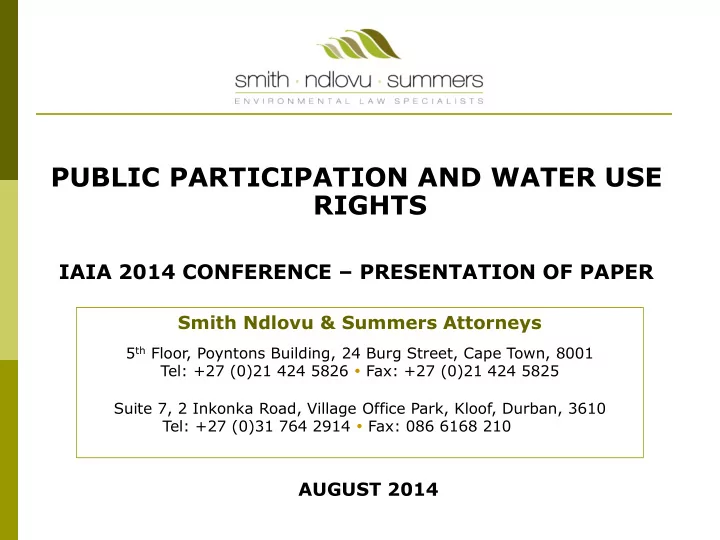

PUBLIC PARTICIPATION AND WATER USE RIGHTS IAIA 2014 CONFERENCE – PRESENTATION OF PAPER Smith Ndlovu & Summers Attorneys 5 th Floor, Poyntons Building, 24 Burg Street, Cape Town, 8001 Tel: +27 (0)21 424 5826 Fax: +27 (0)21 424 5825 Suite 7, 2 Inkonka Road, Village Office Park, Kloof, Durban, 3610 Tel: +27 (0)31 764 2914 Fax: 086 6168 210 AUGUST 2014
THE ROLE OF PUBLIC PARTICIPATION Realisation of environmental rights is grounded in proper performance of regulatory (administrative) functions by Government Relationship therefore exists between S33 and S24 of the Constitution ADMINISTRATIVE ENVIRONMENTAL JUSTICE RIGHTS RIGHTS ENVIRONMENTAL DECISION MAKING
THE ROLE OF PUBLIC PARTICIPATION Sustainable development requires the integration of social, economic and environmental factors in the planning, implementation and evaluation of decisions Public participation enables the ventilation of these issues Public participation links citizens to environmental governance
THE ROLE OF PUBLIC PARTICIPATION The importance of public participation in environmental decision-making has been recognised by the Courts: Earthlife Africa – public participation = critical component of just administrative action; public participation at all stages of decision-making Save the Vaal – audi -rule applies when application for a mining licence is made; audi - rule is particularly important in light of enormous damage mining can do to the environment
PUBLIC PARTICIPATION IN NEMA Public participation as a tool for ensuring administrative justice is evident in a number of laws which make up South Africa’s environmental regulatory framework NEMA – underlying framework for environmental law in SA
PUBLIC PARTICIPATION IN NEMA NEMA sets out environmental management principles aimed at guiding all administrative decision-making affecting the environment NEMA recognises that sound environmental decision making is intrinsically linked to the principle of just administrative action
PUBLIC PARTICIPATION IN NEMA NEMA – Section 2 principles “The participation of all interested and affected parties in environmental governance must be promoted, and all people must have the opportunity to develop the understanding, skills and capacity necessary for achieving equitable and effective participation, and participation by vulnerable and disadvantages persons must be ensured”
PUBLIC PARTICIPATION IN NEMA NEMA and the EIA Regulations EAP must conduct at least the public participation process set out in the EIA Regulations EAP must open and maintain I&AP register EAP must consider all comments from I&APs on any reports prepared
PUBLIC PARTICIPATION IN NEMA Despite there being room for improvement, the public participation and appeal processes in NEMA provide a yardstick against which to measure public participation in water use licencing
PUBLIC PARTICIPATION IN NATIONAL WATER ACT NWA – regulates lawful water use Licencing of water use required when not authorised by Schedule 1, existing lawful use or general authorisation Section 41 sets out procedure for licence applications Section 41(2)(c) – licencing authority “ may ” invite comments, “ may ” require applicant to invite comments Section 148(1)(f) of the NWA: right of appeal to the Water Tribunal “ by the applicant or by any other person who has timeously lodged a written objection against the application ”
PUBLIC PARTICIPATION IN NATIONAL WATER ACT Interpretation of section 41 and 148(1)(f) The Anderson case (Water Tribunal) No right of appeal to WT if comments from I&APs were not invited – “ written ” objection can only refer to formal objection “ invited ” Appellants who were not invited to submit objections accordingly have no right of appeal WT continued to apply the approach in Anderson case to similar hearings
PUBLIC PARTICIPATION IN NATIONAL WATER ACT Escarpment Environment case (High Court) Participation = essential tool to ensure decisions affecting the environment are scrutinised and made from an informed point of view The WT’s narrow construction of section 148(1)(f) is arbitrary Court set aside decisions of the WT and found that the appellants had standing to pursue an appeal before the WT Court held that the responsible authority is under a duty to take steps in terms of section 41 in a “ proper case ” Court’s decision did not go so far as to say that there “ must ” be public participation in all water use licence applications NWA should be amended to require that public participation “ must ” be undertaken in a manner similar to that provided in NEMA and the EIA Regulations
IMPLICATIONS OF INTEGRATED AUTHORISATIONS S24L(2) of NEMA – integrated authorisations may only be issued if the relevant provisions of NEMA and each of the applicable SEMA’s are complied with NWA Amendment Act – requirement to align and integrate timeframes for water use licencing with NEMA and MPRDA Integrated environmental authorisation will offer better level of public participation for water use component than is generally the case in S41
IMPLICATIONS OF INTEGRATED AUTHORISATIONS NWA Amendment Act also introduces an alternative appeal mechanism for integrated licences – appeal to Minister of Water and Sanitation This appeal is only for the applicant Although there is a right of appeal for any person under S43 of NEMA, this appeal is to Minister of Environmental Affairs or MEC Bearing in mind S148 appeal to Water Tribunal, the range of appellate authorities will likely complicate matters
CONCLUSIONS Inter-related nature of administrative justice and environmental rights is recognised in NEMA NEMA – provision for comprehensive and robust public participation S41 of NWA – falls short of the standard for public participation Valuable input may be overlooked
CONCLUSIONS Escarpment Environment recognises the importance of public participation but does not go so far as to say it “ must ” be undertaken in each water use licence application In practice, public participation may fall through the cracks if left to the discretion of the responsible authority Decision-making regarding water use licencing would benefit from comprehensive provision for public participation
Recommend
More recommend